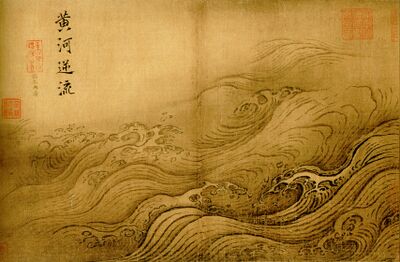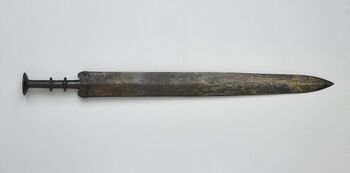Huaxia (Gruppa4)
Huaxia 華夏 | |
|---|---|
| Motto: Towards the Golden Emperor | |
| Largest city | New Zion |
| Official languages | Huaxian |
| Recognised regional languages | Cantonese English |
| Demonym(s) | Huanxi Huaxian (informal) |
| Government | Council of Government |
| Legislature | Grand Huaxia Congress |
| Formal Region of Gruppa4 | |
• First Grand Huaxia Congress | June 11, 1932 |
| Population | |
• 2020 estimate | 543,480,000 |
• 2016 census | 479,254,497 |
| GDP (nominal) | 2020 estimate |
• Total | 11.76 Trillion Satarii |
• Per capita | 65,000 Satarii |
| HDI (2020) | .75 high |
| Currency | Satarius (unofficial) |
| Driving side | left |
Huaxia is an informal grouping of diverse polities united through a common heritage of being descended from a single long-spanning civilization that previously convered all of modern-day Huaxia and beyond. Subsuquently, Huaxians view themselves as inhabitants the inner sphere of "Heaven" in the world, with Huaxia at the cultural and spiritual center. Huaxia today is an extremely diverse region, with countless languages, ethnic groups, and cultures within its borders.
Political power within Huaxia is held by the Banner Kings who have absolute dominion within their territory and over their own militas. These Kings delegate power to various nobles underneath them, who in turn manage various ministries and other affairs. Huaxian localities similarly have district magistrates to administer laws created by the Banner Kings. The Banner Kings, nobles, and other lords and officials convene annually in the Grand Huaxia Congresses to coordinate policy. Additionally, meetings are attended by various special interest groups and secret societies, who have achieved a level of quasi-legitimacy in Huaxian affairs. These secret societies control large parts of the economy and are responsible for much Huaxian political thought, even stretching into Proletsvet and Império where they hold influence. Many of them ideologically hold visions of uniting Huaxia once again, something shared by the various Banner Kings. Each seeks to vie for supremacy over the other and attain complete control over Huaxia, establishing a second great Golden Empire.
Today, Huaxia as a whole does not exist as a unified political body, with no common government, leader, or ideology. It cooperates with its neighbors on regional and international matters without the existence of a codifed political body to enforce any decisions on constituent member states. As a result, Huaxian politics are mired in short-term alliances, political maneuvering, and off-record deals. Additionally, Huaxian relations with Proletsvet and Império are even more complex, with each Huaxian polity having independant relations with non-Huaxian polities, each of which is different in subtle or overt ways, which results in exceptionally convoluted alliances during armed conflict. Periods of armed conflict are made additionally politically complex as Huaxia is the world's foremost arms manufacturer, with the Hairy Men of God solely responsible for over 60% of the world's production of firearms, explosives, armed vehicles, and other arms.
Etymology
The word Huaxia is a combination of the words hua (華), meaning 'beauty', and xia (夏) meaning 'grandness'. Together they form the expression "beautiful grandeur", in reference to the land of the first Golden Empire, the pre-cursor to modern day Huaxia.
History
The history of the region of Huaxia is ancient and incomplete in parts, with many cultural artifacts, documents, and other important items lost during the Grey Period. What survives indicates that Huaxia has been continuously inhabited for at least 4000 years, with the oldest known archeological evidence being clay pots unearthed dating back to ~2500 BC. It has gone through many great upheavals in that time, from the age of the warring kingdoms, to the First Golden Empire, the fall and following grey period, the establishment of the First Grand Huaxia Congress, and the current troubles of the modern era.
First settlement
The first cultures known to inhabit Huaxia were farming and fishing communities, largerly centered around the Golden River in modern day HMOG. The surviving cultural artifacts found in the area dated to those times indicate that these people were comparatively civilized relative to their neighbors, or they represented themselves as such, referring to the people outside the river region as barbarous. Nothing else is known about these barbarians, other than they were antagonists to the way of life of the early Huaxians.
The Golden Empire
Based on traditional accounts, archeological evidence, and surviving cultural artifacts, around the year 390 a member of one of the river tribes rose to prominance by uniting the feuding clans under his rule. In addition, he is credited with the invention of several then-revolutionary ideas, notably the saddle, pottery, and irrigation. Through his political will, military might, and revolutionary scientific advances, the tribal lord conquered all of the river lands, and then the region beyond, forming a Great Golden Empire that encompassed all of modern-day Huaxia and into parts of what is now Proletsvet and Império.
The reign of the Golden Emperor was an age of unrivalved prosperity and development for Huaxia; many large cities were founded along the Golden River and outlands, each of which was ruled by a Banner Lord loyal to the Emperor. The population grew to at least 25,000,000 people as the river was used to create an extensive irrigation system to grow rice and other staple foodcrops. Trade flourished as rice and other surplus goods like pottery and metals were traded to all regions of the Empire and beyond, with Huaxias centralized location in the world facilitating trade between what is now Proletsvet and Imperio. The Imperial army, built from a mixture of volunteers, conscripts, and loaned troops from the banner lords, maintained order in the country and protected its constantly-expanding borders from bandits and barbarians. The Golden Emperor also established a system of writing and an education system to teach it to all Imperial subjects, a system of writing that evolved over the centuries and is known today as the Huaxian language.
Evidence of the death of the Golden Emperor is unclear, with contraditory accounts from a variety of sources. While some claim that he disappeared from the Imperial City around 470, never to be seen again, several surviving cultural artifacts indicate that he was slain in battle defending the City from invading barbarians.
The disappearance or death of the First Golden Emperor around the year 470 marked the beginning of the decline of the Golden Empire. He was succeeded by a number of Emperors, each able to rule the Empire to varying degrees of effectiveness, but none able to match the leadership of the first Emperor. The last recorded Golden Emperor ascended to the throne in the year 896, in his rule was marked by economic downturn, civil unrest, and banner lords defying Imperial rule.
Grey Period
Archeological evidence from dates after 900 is sparse, with few surving relics from these times found. The artifacts that were recovered are markedly different from Golden Era finds, lacking the same craftsmanship and attention to detail found in traditional imperial work. They primarily consist of finds from burial mounds, crude carved tablets, and fragmented journal accounts from foreign traders and explorers present in Huaxia around these times. Together, the evidence seems to indicate the sudden collapse of the Golden Empire, likely in as short a time as a year. The high numbers of burial mounds in the regions surrounding the golden cities, all dated to the same period, are indicative of a high number of deceased high-ranking military and political figures being buried in that time. Anthropologists speculate that during this time, following a long period of decline for the Golden Empire, large numbers of barbarians invaded, likely originating from the outlands to the north. Lacking a strong leader the unite the Banner Lords in defense against the aggressors, the seperate kingdoms abandoned their previous alliances and focused only on the defense of their own cities. All but a few of the strongest kingdoms were destroyed, with those surviving being severely weakened by the damage caused to their lands and people by the collapse.
Struggling to recover following their near-destruction, the seperate kingdoms largely closed their borders to each other and to the world, focusing all their efforts on rebuilding their lands and infastructure. Culture languished during this time, as each went their own way, Huaxian identity began to drift apart and become fragmented. Each saw themself as the sole legitimate inheritor of the previous Golden Empire, and distrusting the failure of the last Golden Emperor, would not compromise and allow any but themselves to ascend to the Imperial Throne.
Age of Swords
In the centuries following the collapse of the Golden Empire, war and armed conflict was common in the region of Huaxia. Without an Empire and a strong central government to quell the fighting amongst the banner lords, old feuds resurfaced and lords fought one another for control of the cities and the surrounding country. Many great powerful kingdoms rose to prominence in Huaxia at this time, often growing at the expense of their neighbors or other conquests. Alliances between the Banner Kings were broken as quickly as they were forged, with opportunistic politicians and commanders seeking to capitalize on any possible advantage.
Huaxia remainded in this state for almost 1000 years, with many Kingdoms eventually able to attain a high degree of sophistication and development, but none able to unite all the lands of Huaxia under one banner.
First Grand Huaxia Congress
Modern Era
Geography
Politics
While not being a unified political body like other regions in the world, Huaxian polities cooperate with one another on regional and interregional matters. In addition to direct diplomatic missions between polities, all Huaxian polities meet yearly for the Grand Huaxia Congress in the city of New Zion, HMOG. Banner Lords from each polity appoint 1-3 councillors to the congress, who serve their position until they are replaced. Individuals chosen to be councillors usually are experts in politics, economics, or other fields of importance, and serve on the congressional council as advisors to the Banner Lords. While their judgement is intended to be unbiased, impartial council, there is historical precedent of councillors being appointed to further the political goals of a single polity, instead of representing the interests of all Huaxians.
Lists of Polities
| Name | Capital | Population (2020 estimate) | Area (km²) | Head of State | Head of Government | Government type |
|---|---|---|---|---|---|---|
| New Zion | 520,000,000 | Area TBD | HoS | HoG | Theocratic Deleuzian-Fascist Aristocracy | |
| Omhaya | 14,880,000 | 65,000 | Warlord Sovereign | Unitary Pirate Syndicacy | ||
| Huangjin lu | Capital | 8,600,000 | Area TBD | HoS | HoG | Taoist Anti-Modernist Monarchy |



